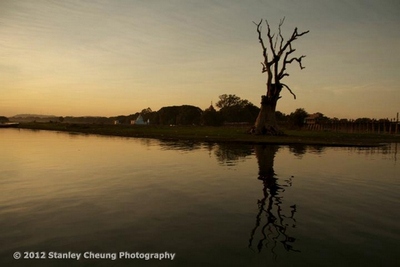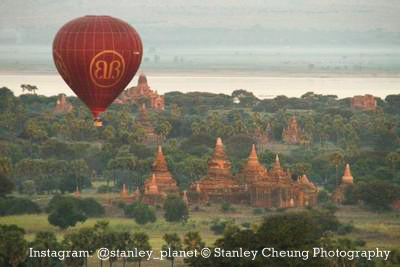Home > Myanmar > Bagan



Bagan 蒲甘
Bagan is one of the richest archaeological and historical sites in Asia, a large area of more than 42 square km, with more than 2,000 pagodas and temples, all set in a vast plain beside the legendary Ayeyarwaddy River. More popularly known as the "City of Four Million Pagodas". Today is considered as one of the wonders of the world.
During the Bagan Era (11th to 13th century), Burmese was written for the first time. Bagan was the origin of Buddhism, as still practiced nowadays, and was the seat of religious learning for clergy and laity. Maingalazedi is one of Bagan's last great stupas to have been erected and is a fine example of the skills of the temple builders. It is also a favourite spot to catch the sunset. Foreign visitors to Bagan can be found on the steep steps waiting for the magical moment; as the sun sinks behind the already misty Ayeyarwaddy.
 Highlights include:
Highlights include:
Shwezigon Pagoda 瑞西孔佛塔
The Shwezigon Pagoda constructed by King Anawyahtar start in 1059. The beginning construction completed in 1090 and repairs completely by King Kyanhsisthar. This golden paogda was the first monument built in the Myanmar style, the prototype for later pagodas. Nat (Spirit) images can be found within its precincts. It is of 40 meters in height.
- a prototype of later Myanmar stupas Gubyaukyi Pagoda - an early period pagoda with paintings still preserved inside Htilominlo Pagoda - traces of ancient murals are still visible Ananda Pagoda - one of the finest, largest and best preserved Anada Ok Kyaung - one of the few surviving brick monastery buildings of the Early Bagan period.
Ananda Temple 阿南達佛塔
The Ananda Temple constructed by King Kyansisthar in 1090, complete in 1105. Ananda is a felicitous and harmonious blending of the best in Bagan, Mon and Indian architectural styles of those days. The foundation shape of the temple is in "X" shape and it was not seen with this style before. There are four hugh Buddha images in standing position, three paths around the pagoda. Eight relieves depicting the life of the Buddha from his birth to his enlightenment. The architectural arrangement that allows light to get into the inner recesses of the Ananda pagoda has remained a marvel to this day.
Dhammayangyi Pagoda 敵瑪洋吉佛塔
Dhammayangi Temple was built by King Narathu in 1165, lasting for five years. It is Bagan's mot massive temple. The temple was not finished but it displayed the finest brickwork. The King managed strictly with the layer of bricks. Architectural style is similar to the Ananda Temple.
Payathonzu Pagoda
- a 13th century complex of three interconnected shrines. Manuha Paya - said constructed by the captured king Manuha and where in the back there is reclining Buddha in very cramped quarters, supposedly reflecting the king's displeasure at captivity. sunset view - as the day wanes we can watch the beautiful sunset from one of the pagodas selected by the tour guide for best viewing. Evening boat ride on the Ayeyarwaddy River - take a scenic evening boat ride on the river which ends at Lawkananda Kyaung, a riverside monastery rich in history and where the sunset views are excellent.
Excursion to Mt. Popa 波巴山
- the morning drive to the Mt. Popa which rose from the ground in a massive earthquake in 442 BC. Mt. Popa is renowned as the home of the Nats (Spirit Gods) and for its' panoramic view of the local tropical region.
The Mount of Popa is about 32 miles far from Bagan, meaning in Sanskrit is "flower", this solitary peak, coing out of an extinct volacno and home of the Nats, the Myanmar spirits worshipped still today is defined as the "Olympus of Myanmar".Rich in legends, Mount Popa is an ethereal place, especially during the Nat festival (During April) attracts thousands of pilgrims.
|
|---|
Newsletter Subscription: 訂閱最新旅遊資訊
Site Map · Privacy Policy 私隱政策(只附英文版)
© 2020 Exotic-Holidays.hk · All Rights Reserved.
![]()